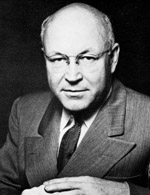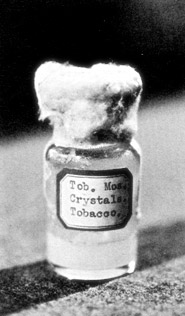Discovering that Viruses are Made Up of Protein and Nucleic Acid

Stanley, Wendell
Courtesy of the Rockefeller Archive Center
In 1935 Wendell Stanley (1904-1971), a young chemist working in the Rockefeller Institute's laboratories in Princeton, NJ, purified a virus in the form of needle-shaped crystals with the chemical properties of a protein. It was perhaps the most startling discovery to date in the Institute's history. How could a virus, with its ability to infect and multiply, also be an inanimate chemical—an inert molecule? Stanley's finding prompted discussion of the question, "what is life?" as well as much criticism. Further research elsewhere, confirmed in Stanley's laboratory, soon demonstrated that the infectious substance was in fact a combination of protein and the nucleic acid, RNA. The results called attention to the similar reproductive powers of viruses and genes (not yet known to be DNA), and helped lay the groundwork for modern molecular biology. For his achievements, Stanley shared the Nobel Prize in Chemistry in 1946 with his Rockefeller colleague John H. Northrop (1891-1987) and James B. Sumner.
Stanley experimented with tobacco mosaic virus (TMV), which causes spots on the leaves of infected plants. By the time he began his studies in the early 1930s, TMV was well known to laboratory researchers. Others had shown that it could be manipulated chemically without losing its ability to infect. Stanley decided to apply to TMV methods for crystallizing proteins that had been developed by his Rockefeller colleagues John Northrop and Moses Kunitz. Although more than 300 human, animal, and plant viruses were known to science, when Stanley began his research it was not known whether viruses were, in his words, "inorganic, carbohydrate, hydrocarbon, lipid, protein, or organismal in nature."
In addition to opening questions about the basic nature of viruses that set the course for the field of virology, Stanley's own research had a more immediate impact on medicine. During World War II, he turned his attention to developing an inactivated vaccine for viral influenza. He used a Sharples centrifuge—a piece of equipment widely used in the dairy industry at the time—to obtain concentrated and purified quantities of the virus. The centrifuge's large capacity and efficiency made it possible to scale up production of the vaccine, and Stanley's method was used in the development of commercial vaccines. In the late 1950s and 1960s Stanley advocated for research on tumor viruses to aid in understanding human cancers, testifying before Congress to support the National Cancer Institute, and helping to support the passage of the National Cancer Act in 1971.

Tobacco mosaic virus
Wendell M. Stanley received his undergraduate education at Earlham College (1926) and the PhD from the University of Illinois (1929). He remained at Illinois as an instructor, and a National Research Council Fellowship allowed him to spend the academic year 1929-1930 in Munich working with Heinrich Wieland. In 1931 Stanley was appointed to a position at the Rockefeller Institute in the laboratory of W.J.V. Osterhout, and in 1932 he moved to the division of plant pathology under Louis Kunkel. He became a member of the Institute in 1940. In 1948 Stanley joined the University of California at Berkeley as founder of the Virus Laboratory and chairman of the department of biochemistry (1948-1953). He later became professor of virology and chairman of the virology department (1958) and remained at Berkeley the rest of his career, retiring in 1969. In addition to the Nobel Prize (1946), Stanley's achievements were recognized with more than a dozen honorary degrees; election to the American Philosophical Society (1940) and the U.S. National Academy of Sciences (1941); the Nichols Medal of the American Chemical Society; the Presidential Certificate of Merit (1948); the American Cancer Society's Medal for Distinguished Service in Cancer Control (1963); and selection as president of the Tenth International Cancer Congress (1970).
Selected Publications
Stanley W. Isolation of a crystalline protein possessing the properties of tobacco-mosaic virus. Science, 1935, 81: 644-645
Stanley W. Chemical studies on the virus of tobacco mosaic. VI. The isolation from diseased Turkish tobacco plants of a crystalline protein possessing the properties of tobacco-mosaic virus. Phytopathol, 1936, 26: 305-320
Loring HS and Stanley W. Isolation of crystalline tobacco mosaic virus protein from tomato plants. J Biol Chem, 1937, 117: 733-754
Loring HS and Stanley W. The properties of virus proteins. Cold Spring Harbor Symp Quant Biol, 1938, 6: 341-360
Ross AF and Stanley WM. The sulfur and phosphorus contents of tobacco mosaic virus. J Am Chem Soc, 1939, 61: 535-540
Lauffer MA and Stanley WM. The physical chemistry of tobacco mosaic virus protein. Chem Rev, 1939, 24: 303-321
Stanley WM. The preparation and properties of influenza virus vaccines
concentrated and purified by differential centrifugation. J Exp Med,
1945, 81: 193-218
http://jem.rupress.org/cgi/reprint/81/2/193
Further Reading
Stanley WM. The isolation and properties of crystalline Tobacco Mosaic Virus. In: Nobel Lectures, Chemistry 1942-1962, Elsevier Publishing Company, Amsterdam, 1964
Cohen SS. Stanley, Wendell Meredith. In Dictionary of Scientific Biography, Gillispie CC, ed. New York: Scribner's, YEAR, VOLUME, pp. 841-848
Stanley WM and Valens EG. Viruses and the Nature of Life. New York: Dutton, 1961
Creager ANH. The Life of a Virus: Tobacco Mosaic Virus as an Experimental Model, 1930-1965. Chicago: Univ Chicago Press, 2001
Corner GW. A History of the Rockefeller Institute, 1901-1953. Origins and Growth. New York: Rockefeller Institute Press, 1964, pp. 318-322
Links
The Nobel Prize in Chemistry, 1946
http://nobelprize.org/nobel_prizes/chemistry/laureates/1946/index.html
Four University of California Bioscientists:
Wendell Meredith Stanley (1904-1971)
http://bancroft.berkeley.edu/Exhibits/Biotech/stanley.html
